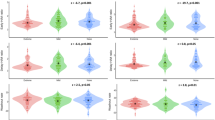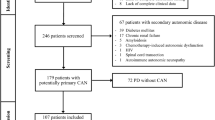Abstract
Orthostatic hypotension and supine hypertension frequently coexist in Parkinson’s disease (PD) patients, leading to visceral damage and increased mortality rates. The aim of this paper is to analyze the frequency and association of both conditions in a sample of outpatients with PD. A total of 111 patients, diagnosed with PD, were studied. Disease duration, treatment, cardiovascular risk factors, UPDRS I-IV and Scopa Aut scale scores were reported. Subjects underwent 24-h ambulatory blood pressure (BP) monitoring and were assessed for orthostatic hypotension. We compared our results with those published in 17,219 patients using the same protocol and the same type of device. Overall, 71.1 % had no proper circadian rhythm. This frequency was significantly higher than that of the control population (48 %). The prevalence of the nondipper or riser patterns was higher in patients with orthostatic hypotension (77.8 vs. 66.7 %). There was a correlation between nightly increases in diastolic blood pressure and changes in BP during the orthostatic test. Patients taking higher doses of treatment had less decreases in SBP (cc:−0.25; p = 0.007) and DBP (cc:−0.33; p < 0.001) at night, however there was no relation with drug type. The majority of patients with Parkinson’s disease show an altered circadian rhythm of blood pressure. Patients with a non-dipper or riser pattern on 24 h ABPM exhibited a higher prevalence of autonomic disorders (orthostatic hypotension) and received higher doses of dopaminergic treatment. A day–night variation in diastolic blood pressure was the most important marker of these findings.


Similar content being viewed by others
References
Kaufmann H, Goldstein DS (2007) Autonomic dysfunction in Parkinson’s disease. Handb Clin Neurol 83:343–363
Goldstein DS, Pechnik S, Holmes C, Eldadah B, Sharabi Y (2003) Association between supine hypertension and orthostatic hypotension in autonomic failure. Hypertension 42(2):136–142
Jones CD, Loehr L, Franceschini N, Rosamond WD, Chang PP, Shahar E et al (2012) Orthostatic hypotension as a risk factor for incident heart failure: the atherosclerosis risk in communities study. Hypertension 59(5):913–918
Schmidt C, Berg D, Prieur S, Junghanns S, Schweitzer K, Globas C et al (2009) Loss of nocturnal blood pressure fall in various extrapyramidal syndromes. Mov Disord 24(14):2136–2142
Qiu C, Hu G, Kivipelto M, Laatikainen T, Antikainen R, Fratiglioni L et al (2011) Association of blood pressure and hypertension with the risk of Parkinson disease: the National FINRISK Study. Hypertension 57(6):1094–1100
Becker C, Jick SS, Meier CR (2008) Use of antihypertensives and the risk of Parkinson disease. Neurology 70(16 Pt 2):1438–1444
Gorostidi M, Sobrino J, Segura J, Sierra C, de la Sierra A, Hernandez del Rey R et al (2007) Ambulatory blood pressure monitoring in hypertensive patients with high cardiovascular risk: a cross-sectional analysis of a 20,000-patient database in Spain. J Hypertens 25(5):977–984
Plaschke M, Trenkwalder P, Dahlheim H, Lechner C, Trenkwalder C (1998) Twenty-four-hour blood pressure profile and blood pressure responses to head-up tilt tests in Parkinson’s disease and multiple system atrophy. J Hypertens 16(10):1433–1441
Kurata T, Kametaka S, Ohta Y, Morimoto N, Deguchi S, Deguchi K et al (2011) PSP as distinguished from CBD, MSA-P and PD by clinical and imaging differences at an early stage. Intern Med 50(22):2775–2781
Wilcox CS, Aminoff MJ, Slater JD (1977) Sodium homeostasis in patients with autonomic failure. Clin Sci Mol Med 53(4):321–328
Parati G, Pomidossi G, Albini F, Malaspina D, Mancia G (1987) Relationship of 24-hour blood pressure mean and variability to severity of target-organ damage in hypertension. J Hypertens 5(1):93–98
Sommer S, Aral-Becher B, Jost W (2011) Nondipping in Parkinson’s disease. Parkinson’s disease 2011:897586
Maule S, Papotti G, Naso D, Magnino C, Testa E, Veglio F (2007) Orthostatic hypotension: evaluation and treatment. Cardiovasc Hematol Disord Drug Targets 7(1):63–70
Velseboer DC, de Haan RJ, Wieling W, Goldstein DS, de Bie RM (2011) Prevalence of orthostatic hypotension in Parkinson’s disease: a systematic review and meta-analysis. Parkinsonism Relat Disord 17(10):724–729
Suzuki M, Urashima M, Oka H, Hashimoto M, Taira K (2007) Cardiac sympathetic denervation in bradykinesia-dominant Parkinson’s disease. NeuroReport 18(17):1867–1870
Berganzo K, Tijero B, Somme JH, Llorens V, Sanchez-Manso JC, Low D et al (2012) SCOPA-AUT scale in different parkinsonisms and its correlation with (123) I-MIBG cardiac scintigraphy. Parkinsonism Relat Disord 18(1):45–48
Spiegel J, Hellwig D, Farmakis G, Jost WH, Samnick S, Fassbender K et al (2007) Myocardial sympathetic degeneration correlates with clinical phenotype of Parkinson’s disease. Mov Disord Off J Mov Dis Soc 22(7):1004–1008
Deuschl G, Schade-Brittinger C, Krack P et al (2006) A randomized trial of deep-brain stimulation for Parkinson’s disease. N Engl J Med 355:896–908
Goldstein DS, Eldadah BA, Holmes C et al (2005) Neurocirculatory abnormalities in Parkinson disease with orthostatic hypotension: independence from levodopa treatment. Hypertension 46:1333–1339
Acknowledgments
Funding: this work was supported by Department of Industry of the Basque Government (SAIOTEK S-DI11BF002).
Conflicts of interest
No, there are no competing interests. The research was funded by Department of Industry of the Basque Government, but nobody of authors receive financial gain.
Author information
Authors and Affiliations
Corresponding author
Rights and permissions
About this article
Cite this article
Berganzo, K., Díez-Arrola, B., Tijero, B. et al. Nocturnal hypertension and dysautonomia in patients with Parkinson’s disease: are they related?. J Neurol 260, 1752–1756 (2013). https://doi.org/10.1007/s00415-013-6859-5
Received:
Revised:
Accepted:
Published:
Issue Date:
DOI: https://doi.org/10.1007/s00415-013-6859-5




